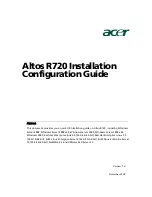Chapter 3: Configuration Concepts
43
Disk Pools
A disk pool is a set of drives that is logically grouped together in the storage array.
The drives in each disk pool must be of the same drive type and drive media type, and
they must be similar in size. As with a volume group, you can create one or more
volumes in the disk pool. However, the disk pool is different from the volume group
in the way that the data is distributed across the drives that comprise the disk pool.
In a volume group, the data is distributed across the drives based on a RAID level.
You can specify the RAID level when you create the volume group. The data for each
volume is written sequentially across the set of drives in the volume group.
In a disk pool, the storage management software distributes the data for each volume
randomly across a set the drives in the disk pool. Each disk pool must have a
minimum of eleven drives. Although there is no limit on the maximum number of
drives that can comprise a disk pool, the disk pool cannot contain more drives than the
maximum limit for each storage array. The storage management software
automatically configures the RAID level when you create the disk pool. You cannot
set or change the RAID level of disk pools or the volumes in the disk pools.
NOTE
Because disk pools can co-exist with volume groups, a storage array can
contain both disk pools and volume groups.
Disk Pool Benefits
Better use of drives
– When you add drives to a storage array, the storage
management software automatically detects the drives and prompts you to create
a single disk pool or multiple disk pools based on the drive type and the current
configuration. If disk pools were previously defined, the storage management
software provides the option of adding the compatible drives to an existing disk
pool. When new drives are added to an existing disk pool, the storage
management software automatically redistributes the data across the new
capacity, which now includes the new drives that you added. The data in the
volumes remain accessible when you add the drives to the disk pool. When you
delete disk pool volumes, the capacity of those volumes is added to the total
usable capacity of the disk pool and, therefore, can be reused.
NOTE
You have the option to manually create a disk pool, if you prefer not to proceed
with the automatic disk pool creation process.
Reduced hot spots
– A host might access some drives in the volume group for
data more frequently than other drives because of the sequential manner in which
the data is written to the drives. This frequency of access to drives creates hot
spots in the volume group. In a disk pool, the hot spots are significantly reduced
because of the random manner in which the data is spread across a large number
of drives. The reduction of hot spots in the disk pool improves performance of the
storage array.
Summary of Contents for InfiniteStorage 4000 Series
Page 34: ...22 ExitStatus ...
Page 48: ...36 Adding Comments to a Script File ...
Page 110: ...98 Starting Stopping and Resuming a Snapshot Legacy Rollback ...
Page 168: ...156 Interaction with Other Premium Features ...
Page 182: ...170 Interaction with Other Premium Features ...
Page 192: ...180 SSD Cache Management Tasks ...
Page 216: ...204 RecoveryOperations ...
Page 218: ...206 Show Storage Array ...
Page 219: ...Appendix A Examples of Information Returned by the Show Commands 207 ...
Page 220: ...208 Show Storage Array ...
Page 221: ...Appendix A Examples of Information Returned by the Show Commands 209 ...
Page 222: ...210 Show Storage Array ...
Page 223: ...Appendix A Examples of Information Returned by the Show Commands 211 ...
Page 224: ...212 Show Storage Array ...
Page 225: ...Appendix A Examples of Information Returned by the Show Commands 213 ...
Page 226: ...214 Show Storage Array ...
Page 227: ...Appendix A Examples of Information Returned by the Show Commands 215 ...
Page 228: ...216 Show Storage Array ...
Page 229: ...Appendix A Examples of Information Returned by the Show Commands 217 ...
Page 230: ...218 Show Storage Array ...
Page 231: ...Appendix A Examples of Information Returned by the Show Commands 219 ...
Page 233: ...Appendix A Examples of Information Returned by the Show Commands 221 ...
Page 234: ...222 Show Controller NVSRAM ...
Page 253: ...Appendix A Examples of Information Returned by the Show Commands 241 ...
Page 254: ...242 ShowDrive ...
Page 255: ...Appendix A Examples of Information Returned by the Show Commands 243 ...
Page 256: ...244 ShowDrive ...
Page 257: ...Appendix A Examples of Information Returned by the Show Commands 245 ...
Page 258: ...246 ShowDrive ...
Page 268: ...256 ConfigurationUtility ...
Page 275: ......
Page 276: ...Copyright 2012 NetApp Inc All rights reserved ...


















